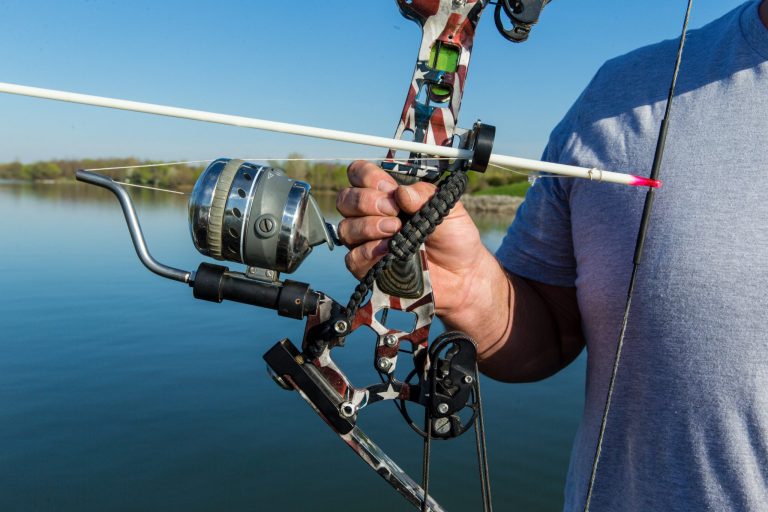
By Rich Porter
Paragraph Nebraska’s public waters have enthralled me for more than 30 years. I first picked up a bow in 1988, and very quickly, bowfishing became a lifelong passion. Stalking a fish, unleashing an arrow and hoping for the best – the thrill is similar to hunting. I will always choose fishing with a bow over a rod and reel.
Another reason why I love bowfishing so much – bowfishers still account for a small percentage of anglers in Nebraska, which means the shooting opportunities are endless. With so little pressure on our lakes and rivers for carp and gar, the time to start bowfishing is now.
Where to Bowfish
You won’t find many big reservoirs without an abundance of common carp. Some have buffalo and gar, and few might hold big, old grass carp. I’ve had the pleasure of shooting many lakes in Nebraska, and my favorites are Harlan County, Medicine Creek, McConaughy, Swanson, Merritt and Calamus.
Don’t overlook lakes that connect to the canal system along the Platte River, as well as any lake that gets flooded by the Missouri, Platte or Elkhorn rivers. All these water bodies will likely provide plenty of shooting opportunities.
Rivers also can be amazing places to stalk a variety of fish. Gar, buffalo, grass, silver and the immense bighead carp all reside in our many rivers and streams.
Gavins Point Dam, considered the mecca among Nebraska bowfishers, is easy to shoot from the bank or inside a boat. May and June are the best months to shoot at Gavins Point, when huge schools of bigheads and silver carp can be expected below the dam. Opportunities for buffalo carp, common carp and gar will be plentiful both above and below the dam.
What to Bring
Wading in a pair of old tennis shoes and shorts is the way most people got started on bowfishing. Gear is fairly simple. You’ll need a bow that fits you, several arrows, a reel and components to attach it to the bow, and a heavy-duty arrow rest.
Bowfishing is tough on equipment so purchase rugged, simple gear. I prefer a full capture adjustable arrow rest, such as the Carpzilla, and arrows that have sturdy points like the Cajun Piranha or Muzzy Carp point. Reels specifically designed for bowfishing are the best. If you use a spin cast reel, like I do, consider spraying the line down with silicone before starting your day. Most stores that carry archery supplies can get you set up.
Another important piece of equipment is polarized sunglasses to help you see through the water. A ball cap helps tremendously to shade those glasses, allowing you to see deeper into the water.
Bowfishing Boat
You don’t need a boat to bowfish, but if you’re looking to put one together, width is the first aspect to consider. The wider the boat, the better it will keep 2-4 shooters stabilized while shooting from the bow.
Second, consider the design of the shooting platform or deck. I prefer a deck that sits 15-20 inches above the boat for shooting during daylight hours. This height also allows room for light placement if you decide night shooting is something you want to try.
Also, buy the biggest trolling motor and outboard motor you can afford. A large trolling motor allows you to continue to fish when the boat becomes weighed down by fish. It also makes it easier to access areas that are bogged down with mud and vegetation. Not to mention, if you’re in fast current, the extra power gives you better control and maneuverability.
Shooting Tips
The best time to bowfish is on sunny, calm days. Slowly sneaking up on feeding fish, or maybe getting lucky and catching the proverbial spawn, is an awesome first experience. Even though I now own a bowfishing boat, I still go back to bank fishing on occasion.
My best tip to beginners is to aim low. Then aim lower. In bowfishing, compensating for water refraction is key. The deeper the fish, the lower you need to aim. If a fish is close to the surface or even on the surface, I aim at the very bottom of the belly and dead center of the target. When a fish is deeper, you will have to make bigger adjustments. It is common to shoot 1-2 feet lower than where you see the fish.
Silence is also golden. Any vibrations from your boat can easily spook fish, so tread lightly and try not to bang or drop your arrows. I also turn my trolling motor down or off and coast into the fish.
The most important thing to remember in bowfishing is have fun. If you miss a shot, it’s not a problem – the next target is just around the corner and swimming your way.
